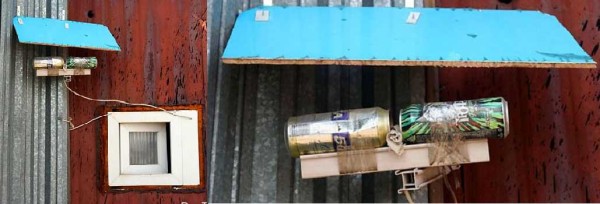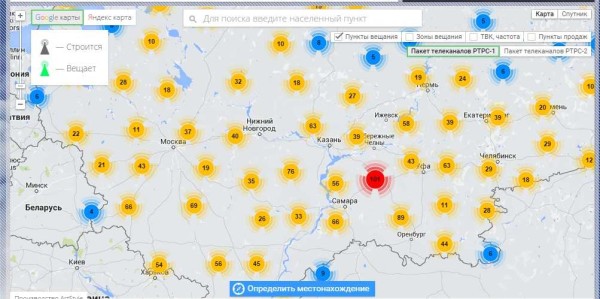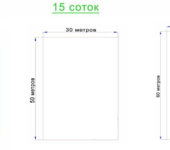How to make a TV antenna with your own hands: for a summer residence and at home
In summer cottages, a television signal can rarely be received without amplification: it is too far from the repeater, the terrain, as a rule, is not uniform, and trees interfere. For the normal quality of the "picture" antennas are needed. Anyone who knows at least a little how to handle a soldering iron can make an antenna for a summer residence with his own hands. Aesthetics outside the city is not so important, the main thing is the quality of reception, simple design, cheapness and reliability. You can experiment and do it yourself.
The content of the article
Simple TV antenna
If the repeater is within 30 km from your dacha, you can make the simplest receiving part. These are two identical tubes connected by a cable. The cable output goes to the corresponding input on the TV.
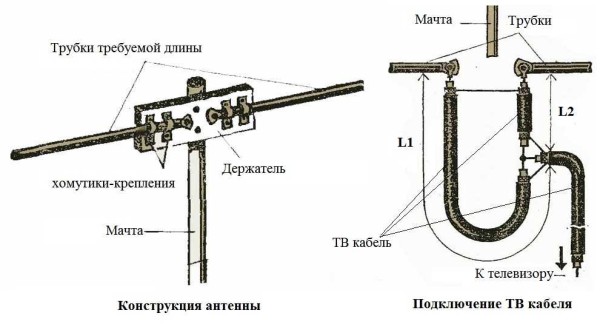
The design of an antenna for a TV in the country: it's very easy to do it yourself (to increase the size of the picture, click on it with the left mouse button)
What is needed to make this TV antenna
First of all, you need to find out at what frequency the nearest TV tower is broadcasting. The length of the "whiskers" depends on the frequency. The broadcasting band is in the range of 50-230 MHz. It is divided into 12 channels. Each needs its own tube length. The list of terrestrial television channels, their frequencies and parameters of a television antenna for self-production will be given in the table.
| Channel number | Channel frequency | Length of the vibrator - from one to the other end of the tubes, cm | Length of cables for the matching device, L1 / L2 cm |
|---|---|---|---|
| 1 | 50 MHz | 271-276 cm | 286 cm / 95 cm |
| 2 | 59.25 MHz | 229-234 cm | 242 cm / 80 cm |
| 3 | 77.25 MHz | 177-179 cm | 187 cm / 62 cm |
| 4 | 85.25 MHz | 162-163 cm | 170 cm / 57 cm |
| 5 | 93.25 MHz | 147-150 cm | 166 cm / 52 cm |
| 6 | 175.25 MHz | 85 cm | 84 cm / 28 cm |
| 7 | 183.25 MHz | 80 cm | 80 cm / 27 cm |
| 8 | 191.25 MHz | 77 cm | 77 cm / 26 cm |
| 9 | 199.25 MHz | 75 cm | 74 cm / 25 cm |
| 10 | 207.25 MHz | 71 cm | 71 cm / 24 cm |
| 11 | 215.25 MHz | 69 cm | 68 cm / 23 cm |
| 12 | 223.25 MHz | 66 cm | 66 cm / 22 cm |
So, in order to make an antenna for a TV with your own hands, you need the following materials:
- The metal pipe is 6-7 cm shorter than the one indicated in the table. Material - any metal: brass, steel, duralumin, etc. Diameter - from 8 mm to 24 mm (usually 16 mm). The main condition: both "mustaches" must be the same: from the same material, the same length, from a pipe of the same diameter with the same wall thickness.
- 75 Ohm TV cable. Its length is determined in place: from the antenna to the TV, plus one and a half meters for the sag and half a meter for the matching loop.
- A piece of thick PCB or getinax (at least 4 mm thick),
- Several clamps or metal strips to secure the pipes to the holder.
- Antenna rod (metal pipe or corner, if the height is not very high - a wooden block, etc.).
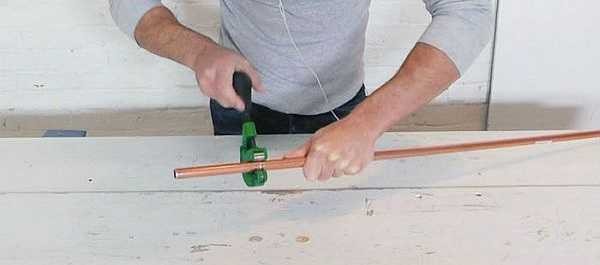
A simple antenna for a summer residence: even a schoolboy can make with his own hands
It would be nice to have a soldering iron, flux for soldering copper and solder on hand: it is advisable to solder all the connections of the central conductors: the image quality will be better and the antenna will work longer. Then the places of the rations must be protected from oxidation: it is best to fill it with a layer of silicone, you can use it with epoxy resin, etc. As a last resort, seal it with electrical tape, but this is very unreliable.
This homemade TV antenna, even at home, will be made by a child. It is necessary to cut off the tube of the length that corresponds to the broadcast frequency of the nearby repeater, then cut it exactly in half.
Assembly order
The resulting tubes are flattened on one side.With these ends, they are attached to the holder - a piece of getinax or textolite 4-6 mm thick (see figure). The tubes are placed at a distance of 6-7 cm from each other, their far ends should be at the distance indicated in the table. They are fixed to the holder with clamps, they must be held firmly.
The installed vibrator is fixed to the mast. Now you need to connect the two "mustaches" through the matching device. This is a cable loop with a resistance of 75 Ohm (type RK-1, 3, 4). Its parameters are indicated in the far right column of the table, and how it is done is on the right side of the photo.
The middle conductors of the cable are screwed (soldered) to the flattened ends of the tubes, their braid is connected with a piece of the same conductor. It is simple to get the wire: cut a piece from the cable slightly larger than the required size and free it from all the shells. Strip the ends and screw them to the cable conductors (it is better to solder).
Then the center conductors are connected from two pieces of the matching loop and the cable that goes to the TV. Their braid is also connected with a copper wire.
The last action: the loop in the middle is attached to the bar, and the cable going down is screwed to it. The bar is raised to the required height and there it is "tuned". To set up, two people are needed: one turns the antenna, the second watches TV and assesses the picture quality. Having determined where the signal is best received from, the hand-made antenna is fixed in this position. In order not to suffer with "tuning" for a long time, look where the neighbors' receivers (terrestrial antennas) are directed. The simplest antenna for a summer residence is made by hand. Set and "catch" the direction by turning it along its axis.
Watch the video on how to cut a coaxial cable.
;
Looped from pipe
This antenna for giving with your own hands is a little more difficult to manufacture: you need a pipe bender, but the reception radius is larger - up to 40 km. The starting materials are practically the same: metal tube, cable and rod.
The bend radius of the pipe is not important. It is necessary that the pipe has the required length, and the distance between the ends is 65-70 mm. Both "wings" should be the same length and the ends should be symmetrical about the center.
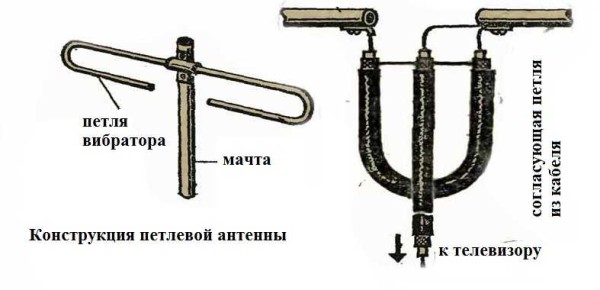
Homemade antenna for TV: a TV signal receiver with a reception radius of up to 40 km is made from a piece of pipe and cable (to enlarge the picture, click on it with the left mouse button)
The pipe and cable lengths are shown in the table. Find out on what frequency the nearest repeater is broadcasting, select the appropriate line. Saw off the pipe of the required size (preferably 12-18 mm in diameter, parameters of the matching loop are given for them).
| Channel number | Channel frequency | Vibrator length - from one end to the other, cm | Length of the cable for the matching device, cm |
|---|---|---|---|
| 1 | 50 MHz | 276 cm | 190 cm |
| 2 | 59.25 MHz | 234 cm | 160 cm |
| 3 | 77.25 MHz | 178 cm | 125 cm |
| 4 | 85.25 MHz | 163 cm | 113 cm |
| 5 | 93.25 MHz | 151 cm | 104 cm |
| 6 | 175.25 MHz | 81 cm | 56 cm |
| 7 | 183.25 MHz | 77 cm | 53 cm |
| 8 | 191.25 MHz | 74 cm | 51 cm |
| 9 | 199.25 MHz | 71 cm | 49 cm |
| 10 | 207.25 MHz | 69 cm | 47 cm |
| 11 | 215.25 MHz | 66 cm | 45 cm |
| 12 | 223.25 MHz | 66 cm | 44 cm |
Assembly
The tube of the required length is bent, making it absolutely symmetrical about the center. One edge is flattened and welded / sealed. Fill in the sands, and close up the second side. If there is no welding, you can plug the ends, just put the plugs on good glue or silicone.
The resulting vibrator is fixed on the mast (rod). They screw it to the ends of the pipe, and then solder the central conductors of the matching loop and the cable that goes to the TV. The next step is to connect a piece of uninsulated copper wire between the braided cables. The assembly is complete - you can proceed to the "setup".
If you don't feel like doing it yourself, read how to choose an antenna for a summer residence here.
Beer can antenna
Despite the fact that she looks frivolous, the image is much better. Checked repeatedly. Try it!
Outdoor beer can antenna
Looking for:
- two tin cans with a capacity of 0.5 liters,
- a piece of wood or plastic about 0.5 meters long,
- a piece of television wire RG-58,
- soldering iron,
- flux for aluminum (if the cans are aluminum),
- solder.
Putting it like this:
- In the bottom of the can, drill a hole (5-6 mm in diameter) strictly in the center.
- Pull the cable through this hole, take it out through the hole in the cover.
- We fix this jar to the left on the holder so that the cable is directed to the middle.
- We take out the cable from the can by about 5-6 cm, remove the insulation by about 3 cm, disassemble the braid.
- We cut the braid, its length should be about 1.5 cm.
- We distribute it over the surface of the can and solder it.
- The center conductor sticking out 3 cm must be soldered to the bottom of the second can.
- The distance between the two banks should be made as small as possible, and fixed in some way. One option is sticky tape or duct tape.
- That's it, the homemade UHF antenna is ready.
End the other end of the cable with a suitable plug, plug it into the TV socket. This design, by the way, can be used to receive digital television. If your TV supports this signal format (DVB T2) or you have a special attachment to your old TV, you can pick up the signal from the nearest repeater. You just need to find out where it is and direct your TV antenna, made with your own hands from tin cans, there.
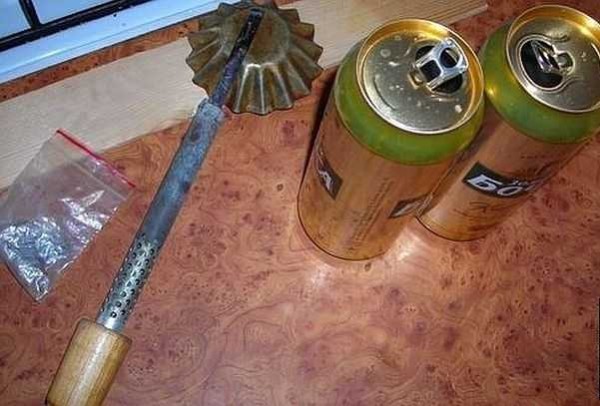
Simple homemade antennas can be made from cans (beer or drinks). Despite the frivolity of the "components", it works very well and is made very simply
The same design can be adapted to receive VHF channels. Instead of 0.5 liter cans, put on 1 liter. Will accept the MV range.
Another option: if there is no soldering iron, or you do not know how to solder, you can make it easier. Tie two cans at a distance of several centimeters to the holder. Strip the end of the cable by 4-5 centimeters (carefully remove the insulation). Separate the braid, twist it into a bundle, make a ring out of it, into which you push a self-tapping screw. Make a second ring from the central conductor and thread the second self-tapping screw through it. Now, at the bottom of one cans, clean (with a sandpaper) a speck to which you screw the screws.
In general, soldering is needed for better contact: it is better to tin and solder the braid ring, as well as the place of contact with the metal of the can. But it turns out well on self-tapping screws, however, the contact is periodically oxidized and needs to be cleaned. How "snow" you will know - why ...
You might be wondering toHow to make a brazier from a cylinder or barrel, you can read about it here.
Antenna for digital TV do it yourself
Antenna design - loop. For this version of the receiver, you will need a wooden plank crosspiece and a TV cable. You will also need electrical tape, a few nails. All.
We have already said that to receive a digital signal, you only need a decimeter terrestrial antenna and an appropriate decoder. It can be built into TVs (new generation) or made as a hotel device. If the TV has a signal reception function in the DVB T2 code, connect the antenna output directly to the TV. If the TV does not have a decoder, you will need to purchase a digital set-top box and connect the output from the antenna to it, and connect it to the TV set.
How to determine the channel and calculate the perimeter of the frames
In Russia, a program has been adopted according to which towers are constantly being built. By the end of 2015, the entire area should be covered with repeaters. Find the tower closest to you on the official website http: //xn--p1aadc.xn--p1ai/when/. The broadcast frequency and channel number are indicated there. The perimeter of the antenna frame depends on the channel number.
For example, on channel 37, broadcasting is carried out at a frequency of 602 MHz. The length of the wave is calculated as follows: 300/602 = 50 cm. This will be the perimeter of the frame. Let's calculate the other channel in the same way. Let it be 22 channel. Frequency 482 MHz, wavelength 300/482 = 62 cm.
Since this antenna consists of two frames, the length of the conductor should be equal to twice the wavelength, plus 5 cm per connection:
- for channel 37, we take 105 cm of copper wire (50 cm * 2 + 5 cm = 105 cm);
- for channel 22, you need 129 cm (62 cm * 2 + 5 cm = 129 cm).
Maybe you are more interested in working with wood? How to make a birdhouse is written here but aboutmaking a doghouse - in this article.
Assembly
Copper wire is best used from the cable that goes to the receiver. That is, take the cable and remove the sheath and braid from it, freeing the central conductor of the required length. Proceed with care it cannot be damaged.
Next, we build a support from the boards, as shown in the figure. To do this, you need to determine the length of the side of the frame. Since this is an inverted square, we divide the found perimeter by 4:
- for channel 37: 50 cm / 4 = 12.5 cm;
- for channel 22: 62 cm / 4 = 15.5 cm.
The distance from one nail to another should correspond to these parameters. Laying copper wire begins on the right, from the middle, moving down and further along all points. Only in the place where the frames come close to one another, do not short-circuit the conductors. They should be at some distance (2-4 cm).
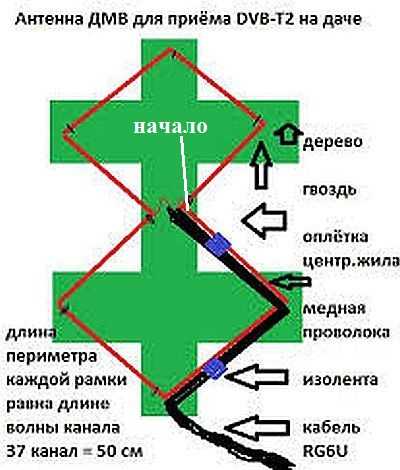
Homemade antenna for digital television
When the entire perimeter is laid, the braid from a cable several centimeters long is twisted into a bundle and soldered (wound, if it is impossible to solder) to the opposite edge of the frame. Next, the cable is laid as shown in the figure, wrapping it with electrical tape (it is possible more often, but the laying route cannot be changed). Then the cable goes to the decoder (separate or built-in). All the antenna for giving with your own hands for receiving digital television is ready.
How to make an antenna for digital television with your own hands - another design - is shown in the video.

